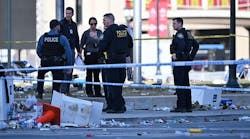Public-private partnerships are not new. Various natural disasters in the late nineteenth and early twentieth centuries began to solidify the role of collaborative public and private sector efforts in public safety scenarios. The Great Chicago Fire of 1871 left a third of the city’s population homeless and federal government assistance was almost non-existent. The fire’s aftermath saw both state and local government partnering with private charities and businesses to facilitate relief efforts, essentially setting the foundation for true public and private cooperative projects that exist today.
Subsequent disasters, including the 1906 San Francisco Earthquake and the 1927 Great Mississippi Flood, ratcheted up government support for response and recovery efforts. Increasing amounts of funding changed hands between the public and private sectors to support post-disaster reconstruction.
Even events closer to home like the September 11, 2001 terrorist attacks, Hurricane Katrina, and the Deepwater Horizon oil spill all highlight the prominence of public-private partnerships in what we now term homeland security. When you consider that 85 percent of the nation’s critical infrastructure is under private sector control, alliances between government and business are not only essential for homeland security, but for municipal and community security as well. Public-private partnerships can enhance hiring, resource utilization, specialization, cross-sector trust, and technological innovation. They are often able to cut across traditional bureaucratic divides within government. And they can enhance public protection in ways not possible for government or businesses acting independently.
To that end, secured and safe city initiatives have created models for successful collaborative efforts across the United States. From New York’s massive municipal video surveillance system and homeland security network to community-supported projects in Atlanta and Baltimore, the goal of creating safe living and business spaces is being embraced by government, law enforcement and the private sector.
“As is the case with a number of large cities, Atlanta has been experiencing severe police shortages for a number of years, and is now on the path to fielding more police, but a protective multiplier was needed. The collective feeling was that surveillance cameras could provide that additional edge. Of course, convincing those financing the primary initiative that a return on investment (ROI) would be realized was a challenge. Business leaders want to see tangible results. This is not always easy when there is not a direct correlation between action and results,” says David Wardell, who is vice president of Operations and Public Safety for the Atlanta Downtown Improvement District, one of the largest partnerships in the country.
Atlanta was the first host of our Secured Cities event three years ago. Since then Secured Cities has had stops in three other cities – Chicago, Philadelphia and Baltimore. As event director, I’m excited to announce that we are returning to Baltimore again this year. Secured Cities will be held November 4-6 at the Baltimore Convention Center. And our hosts from Baltimore’s CitiWatch program are working with us to ensure a unique and learning-filled experience.
Lieutenant Samuel Hood, Director of Law Enforcement Operations for Baltimore’s CitiWatch has been a champion of PPP initiatives, not only in his city, but around the country. A city of more than 600,000, Baltimore plays host for many large events and high-profile venues. When city agencies, law enforcement and others began laying the groundwork for what was to become CitiWatch, there were definite goals in mind:
•Enhance public safety;
•Reduce response times with real-time situational awareness;
•Boost collaboration and coordination among agencies;
•Integrate existing security devices and provide ability to integrate future technologies;
•Facilitate quick communication with field personnel via mobile devices;
•Increase preparedness for natural disasters and special events.
Lt. Hood is quick to admit that the use of cutting edge PSIM and video have helped his department to become more proactive in several areas; he continues to cite the collaborative efforts of both public and private partners. “There are so many agencies, businesses and individuals that create the successful environment we have here,” says Lt. Hood. “We have gotten support from the governor down to the mayor and her staff in helping build this CitiWatch program. We like to think it is a model for other cities to use – big or small. Because at the end of the day, we are all facing similar issues – just the scale is different.”
I encourage you to flip to pages 36 and 37 of this issue to check out more details on the Secured Cities event. You can also go to www.securedcities.com for registration and program information.


